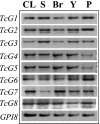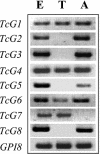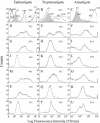Utility of the Trypanosoma cruzi sequence database for identification of potential vaccine candidates by in silico and in vitro screening
- PMID: 15501750
- PMCID: PMC523045
- DOI: 10.1128/IAI.72.11.6245-6254.2004
Utility of the Trypanosoma cruzi sequence database for identification of potential vaccine candidates by in silico and in vitro screening
Abstract
Glycosylphosphatidylinositol (GPI)-anchored proteins are abundantly expressed in the infective and intracellular stages of Trypanosoma cruzi and are recognized as antigenic targets by both the humoral and cellular arms of the immune system. Previously, we demonstrated the efficacy of genes encoding GPI-anchored proteins in eliciting partially protective immunity to T. cruzi infection and disease, suggesting their utility as vaccine candidates. For the identification of additional vaccine targets, in this study we screened the T. cruzi expressed sequence tag (EST) and genomic sequence survey (GSS) databases. By applying a variety of web-based genome-mining tools to the analysis of approximately 2,500 sequences, we identified 348 (37.6%) EST and 260 (17.4%) GSS sequences encoding novel parasite-specific proteins. Of these, 19 sequences exhibited the characteristics of secreted and/or membrane-associated GPI proteins. Eight of the selected sequences were amplified to obtain genes TcG1, TcG2, TcG3, TcG4, TcG5, TcG6, TcG7, and TcG8 (TcG1-TcG8) which are expressed in different developmental stages of the parasite and conserved in the genome of a variety of T. cruzi strains. Flow cytometry confirmed the expression of the antigens encoded by the cloned genes as surface proteins in trypomastigote and/or amastigote stages of T. cruzi. When delivered as a DNA vaccine, genes TcG1-TcG6 elicited a parasite-specific antibody response in mice. Except for TcG5, antisera to genes TcG1-TcG6 exhibited trypanolytic activity against the trypomastigote forms of T. cruzi, a property known to correlate with the immune control of T. cruzi. Taken together, our results validate the applicability of bioinformatics in genome mining, resulting in the identification of T. cruzi membrane-associated proteins that are potential vaccine candidates.
Figures





Similar articles
-
Previously unrecognized vaccine candidates control Trypanosoma cruzi infection and immunopathology in mice.Clin Vaccine Immunol. 2008 Aug;15(8):1158-64. doi: 10.1128/CVI.00144-08. Epub 2008 Jun 11. Clin Vaccine Immunol. 2008. PMID: 18550728 Free PMC article.
-
Antigenicity and diagnostic potential of vaccine candidates in human Chagas disease.PLoS Negl Trop Dis. 2013;7(1):e2018. doi: 10.1371/journal.pntd.0002018. Epub 2013 Jan 17. PLoS Negl Trop Dis. 2013. PMID: 23350012 Free PMC article. Clinical Trial.
-
TcG2/TcG4 DNA Vaccine Induces Th1 Immunity Against Acute Trypanosoma cruzi Infection: Adjuvant and Antigenic Effects of Heterologous T. rangeli Booster Immunization.Front Immunol. 2019 Jun 26;10:1456. doi: 10.3389/fimmu.2019.01456. eCollection 2019. Front Immunol. 2019. PMID: 31293599 Free PMC article.
-
Vaccination approaches against Trypanosoma cruzi infection.Expert Rev Vaccines. 2009 Jul;8(7):921-35. doi: 10.1586/erv.09.45. Expert Rev Vaccines. 2009. PMID: 19538117 Review.
-
Proteins anchored via glycosylphosphatidylinositol and solubilizing phospholipases in Trypanosoma cruzi.Biol Res. 1993;26(1-2):285-312. Biol Res. 1993. PMID: 7670541 Review.
Cited by
-
Treatments and the Perspectives of Developing a Vaccine for Chagas Disease.Vaccines (Basel). 2024 Aug 1;12(8):870. doi: 10.3390/vaccines12080870. Vaccines (Basel). 2024. PMID: 39203996 Free PMC article. Review.
-
Trypanosoma cruzi circulating in the southern region of the State of Mexico (Zumpahuacan) are pathogenic: a dog model.Am J Trop Med Hyg. 2009 Sep;81(3):390-5. Am J Trop Med Hyg. 2009. PMID: 19706902 Free PMC article.
-
Delivery of antigenic candidates by a DNA/MVA heterologous approach elicits effector CD8(+)T cell mediated immunity against Trypanosoma cruzi.Vaccine. 2012 Nov 26;30(50):7179-86. doi: 10.1016/j.vaccine.2012.10.018. Epub 2012 Oct 15. Vaccine. 2012. PMID: 23079191 Free PMC article.
-
A Two-Component DNA-Prime/Protein-Boost Vaccination Strategy for Eliciting Long-Term, Protective T Cell Immunity against Trypanosoma cruzi.PLoS Pathog. 2015 May 7;11(5):e1004828. doi: 10.1371/journal.ppat.1004828. eCollection 2015 May. PLoS Pathog. 2015. PMID: 25951312 Free PMC article.
-
Coping with genetic diversity: the contribution of pathogen and human genomics to modern vaccinology.Braz J Med Biol Res. 2012 May;45(5):376-85. doi: 10.1590/s0100-879x2011007500142. Epub 2011 Oct 28. Braz J Med Biol Res. 2012. PMID: 22030866 Free PMC article.
References
-
- Altschul, S. F., W. Gish, W. Miller, E. W. Myers, and D. J. Lipman. 1990. Basic local alignment search tool. J. Mol. Biol. 215:403-410. - PubMed
-
- Appel, R. D., A. Bairoch, and D. F. Hochstrasser. 1994. A new generation of information retrieval tools for biologists: the example of the ExPASy WWW server. Trends Biochem. Sci. 19:258-260. - PubMed
-
- Aslund, L., L. Carlsson, J. Henriksson, M. Rydaker, G. C. Toro, N. Galanti, and U. Pettersson. 1994. A gene family encoding heterogeneous histone H1 proteins in Trypanosoma cruzi. Mol. Biochem. Parasitol. 65:317-330. - PubMed
-
- Billaut-Mulot, O., R. Fernandez-Gomez, M. Loyens, and A. Ouaissi. 1996. Trypanosoma cruzi elongation factor 1-α: nuclear localization in parasites undergoing apoptosis. Gene 174:19-26. - PubMed
Publication types
MeSH terms
Substances
Associated data
- Actions
- Actions
- Actions
- Actions
- Actions
- Actions
- Actions
Grants and funding
LinkOut - more resources
Full Text Sources
Other Literature Sources
Research Materials
Miscellaneous

